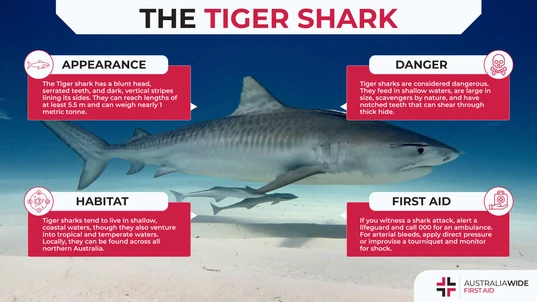Deadly Marine Life: The Tiger Shark

Bites and Stings

Tiger sharks are widely renowned for striped colourations on their sides. They also happen to be one of the largest sharks in the world and have notched teeth designed for maximum damage.
Australia is no stranger when it comes to shark attacks. In 2020 alone, Australia recorded 22 unprovoked shark encounters, which accounted for more than 38% of the worldwide total. This is relatively unsurprising, given Australia has over 25,000 kilometres of coastline, and our waters are home to 170 of the world’s 400 shark species. Our waters are also home to the 12 shark species that are known for unprovoked attacks, including the Great white shark, the Tiger shark, and the Bull shark – the 3 shark species that have been responsible for fatal attacks in the past 20 years. Tiger sharks are particularly formidable predators, as they are large in size, are scavengers by nature, and are known to feed in shallow waters. In fact, National Geographic reports that Tiger sharks are second only to Great whites in the number of recorded attacks on humans. As such, it is important to be wary of the Tiger shark – continue reading for an in-depth understanding of their behaviour and characteristics and the correct procedures for preventing and treating shark attacks.Identification
The Tiger shark, or Galeocerdo cuiver, is the fourth largest shark and the second largest predatory shark in the world, second only to the Great white shark. According to Oceana, they can reach lengths of at least 18 feet (5.5 m) and can weigh up to 2000 pounds (nearly one metric tonne). Tiger sharks also have a blunt head, sharp, highly serrated teeth, and jaws that are powerful enough to crack the shells of sea turtles and clams. Their most distinctive characteristic, however, are dark, vertical stripes covering the sides of their bodies. These stripes are most noticeable in juveniles and tend to fade or disappear as the shark matures.Distribution and Habitat
Tiger sharks have a worldwide distribution, and though they tend to live in shallow, coastal waters, they are also known to venture into tropical and temperate waters. In fact, Tiger sharks have been seen at depths of 1,150 feet (350 m). In Australia, Tiger sharks can be encountered from Windy Harbour in south-western Western Australia and across the tropical north and south all the way to the southern coast of New South Wales.Diet
Despite their exceptional senses of sight and smell, Tiger sharks are widely renowned for having what National Geographic describes as ‘a near completely undiscerning palate’. These sharks are scavengers that have been known to feed on a wide array of both digestible and indigestible items, including fishes, small sharks, turtles, sea snakes, crustaceans, seabirds, marine iguanas, and assorted pieces of rubbish like license plates, car tyres, and fishing gear. Because of their diverse appetite, Tiger sharks are also known to bite people to discern if they are a viable food source. And even if they decide against continuing with an attack, their first bite can be so large as to cause fatalities.Life History
Tiger sharks are viviparous, which means they give birth to live young after a gestation period of between 12 to 16 months. On average, females produce litters of between 30 to 35 pups, though this number can be as low as 10 and as high as 80. Juvenile Tiger sharks can generally be found in estuaries and protected bays, where they prey on coastal fish and invertebrates and escape from the cannibalistic tendencies of adult Tiger sharks. Tiger sharks are regularly hunted for their skin, fins, and livers, the latter of which contains high levels of vitamin A that are processed into vitamin oil. For this reason, and because of their low repopulation rates, Tiger sharks are currently considered a ‘Near threatened’ species.
Unlike deep-water shark species, Tiger sharks often inhabit areas where humans swim. Likewise, their formidable size and notched teeth mean they can easily overpower most animals in the water.
Danger to Humans
Tiger sharks are considered dangerous to humans. Not only do Tiger sharks primarily feed in shallow waters, but they are also large in size, scavengers by nature, and have a mouth full of serrated teeth. As such, they have a higher likelihood of encountering humans compared to deep-water shark species. And their immense size and notched teeth means that even one curious bite can inflict devastating damage.How to Avoid a Shark Attack
There are several ways you can reduce your risk of a shark attack:- Swim in areas that are protected by shark nets and have lifeguards on duty. You should also swim with other people, but do not swim with pets or where people are fishing.
- Avoid entering the water when sharks are more active – for instance, at dawn, dusk, or night.
- Avoid entering murky water – as we mentioned earlier, sharks have been known to use their mouths to discern nearby objects.
- Sharks have been known to bump their prey prior to attacking. As such, if you feel something nudge or brush past you in the water, make your way to the shore as quickly and calmly as possible and alert a lifeguard.
- If a shark heads straight for you, turn and face it while treading in a vertical formation. This will help distinguish you from the shark’s regular prey, such as seals, which typically swim horizontally.
- If a shark is intent on attacking you, you cannot turn and run. Instead, grab any available weapon, such as a paddle or diving knife, and strike at its eyes and gills. If no weapons are available, use your hands to instead gouge at the eyes and gills and to strike the shark in its snout.
First Aid for a Shark Attack
If you witness a shark attack, alert a lifeguard, make sure others are warned, and call Triple Zero (000) for an ambulance. If you need to rescue the person from the water, use a boat as soon as it is safe to do so. Do not put yourself at risk if no lifeguard or boat is available. Then:- If there is an arterial bleed – that is, blood is spurting from the inside thigh or upper arm or leg – apply pressure directly to the wound or improvise a tourniquet as necessary.
- Keep the person still and wrap them in towels to stave off the effects of shock.
Final Thoughts
Films like Jaws might have you believing that Great white sharks are the most fearsome creatures in the water. In reality, Great whites form part of a trio of sharks that are almost exclusively responsible for fatal attacks on humans in the past 20 years. Another member of this trio is the Tiger shark, which has a predilection for feeding in shallow waters. They are also one of the largest sharks in the world and have notched teeth that can shear through the thickest of hides. As such, their encounters with humans can result in significant injuries. It is important to remember, however, that shark attacks (while terrifying) are relatively rare - in fact, you are more likely to die from a hornet, wasp, or bee sting than from a shark attack. Luckily, there are several ways you can reduce your risk of running into a Tiger shark. There are also multiple avenues for fending off a Tiger shark and treating any injuries you may sustain during an attack. To develop even more knowledge and skills to keep yourself safe in the water this summer, book a First Aid course with Australia Wide First Aid today.
Originally published at
https://www.australiawidefirstaid.com.au/resources/tiger-shark
as part of the Australia Wide First Aid Articles Library









